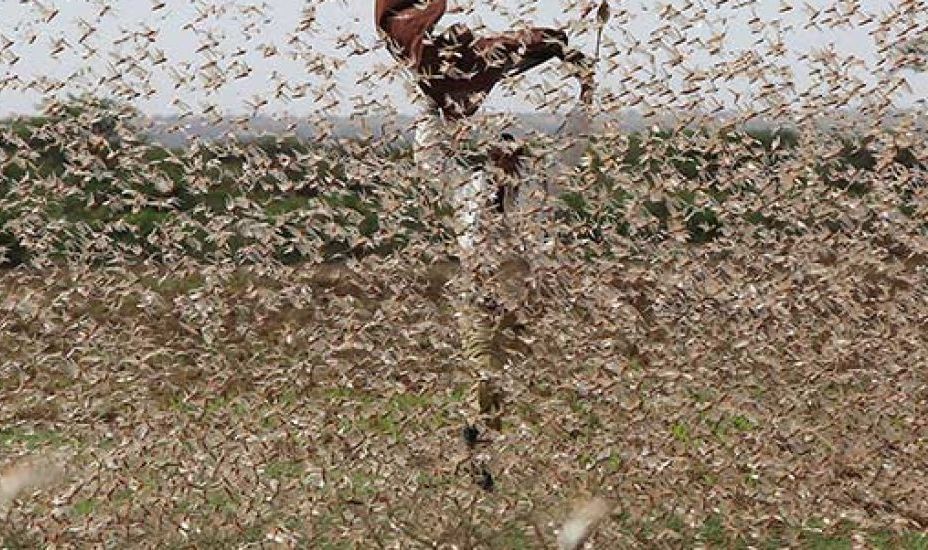Locusts and Fires
Raging fires in Australia and a plague of locusts in east Africa dominated global news at the start of 2020. These rapidly receded in consciousness as the COVID-19 pandemic erupted onto the world, already made dangerously vulnerable by capitalism. The climate devastation was mounting around the world. The world’s economy was tottering on the edge of a major recession. Now these are piled one on another.
Both the fires and locusts were presented as natural disasters that happen. At one level this is true; fire is part of the ecology of Australia and locust swarms have erupted for millennia. However, both were made far worse by climate change.
Usually the evaporated water of the Indian Ocean is carried east to rain over East Asia. However, in certain conditions the moisture flows west onto Arabia and East Africa. This condition, called a positive phase of the Indian Ocean Dipole, happened in the second part of both 2018 and 2019. This produced unusually heavy rainfall in those years, which is the necessary condition for locusts to breed rapidly and transform from solitary insects into huge swarms. Climate change is understood to contribute to the positive dipole phase, with the phase becoming more frequent.
2019 was the hottest and driest year in Australia since records began in 1910, with average temperatures up 2oC, and the summer season lasting a month longer. The positive dipole phase also meant that Australia received less rain than usual and it made the conditions for fire in Australia “much more severe.”
Capitalism is driving climate change, making so-called natural disasters worse. The Australian and Canadian governments, rather than move to renewable energy, subsidize fossil fuels. Canada’s direct subsidy is at least $3.3 billion, plus buying an over-priced pipeline, with provinces adding more subsidies. Australia is estimated to provide $8 billion. The International Monetary Fund estimated that direct and indirect subsidies amount to $60 billion in Canada and $29 billion in Australia. This is in spite of knowing that burning fossil fuels increases the intensity of forest fires, among the many damaging impacts. After decades of failures, it took a worldwide COVID-caused shutdown of society and a deep economic depression to reduce carbon dioxide releases. Although the capitalist class has known about climate change for forty years, they preferred short-term profits for a few rather than long-term resilience for humanity.
In addition, capitalism undermines the ability to respond. East Africa has been devastated by decades of cuts and privatization dictated by international capitalism, on top of centuries of colonialism. Although Australia is a wealthy country, its fire services and preventive actions such as controlled burning had suffered from reduced investment and expenditure, weakening the ability to respond to the fires. Capitalism impacts both the causes and the effects of natural events turning them into serious disasters.
Virus Spread Increasing
Viruses exist in all life. In most cases the host animal has evolved defences so that the virus does not cause high mortality rates. However, viruses can cross from one species to another. Humans are an ideal host for a virus, as there are lots of humans and our lifestyle makes it easy for the virus to spread. It is estimated of 1,415 pathogens (such as bacteria, viruses and parasites) known to infect humans, 61% are due to pathogens that jumped from non-human animals to humans. As humans domesticated animals, there was an increase in diseases jumping to humans, making humans a new home, including smallpox and measles.
Over time most humans developed resistance to smallpox. However, when smallpox reached the Americas with European colonialism, it had a devastating impact as the native peoples of the Americas had no previous exposure or resistance.
Over centuries, increased incursions into territories that had low human density added new viruses that originated in animals. For example, with forest clearance in Africa for agriculture in the 19th century dengue fever changed from being passed between mosquitoes and non-human primates to infecting humans.
Similarly, growth in trade and travel spread diseases. The Black Death is caused by a bacillus that was common in rodents in central Asia, spread between animals by fleas. For a variety of reasons, it became able to spread from human to human and expanded outwards into China, across Asia and reached Europe in 1347.
In recent years, there has been increased jumping of viruses from animals to humans. Kate Jones, of University College London, stated that animal borne infection diseases are an “increasing and very significant threat to global health, security and economies.” Her research found that of 335 diseases that have emerged between 1960 and 2004, 60% came from animals.
It is understood that this increase in diseases jumping is due to increased contact between humans and wildlife. Thomas Gillespie, an Emory University professor, explained, “Major landscape changes are causing animals to lose habitats, which means species become crowded together and also come into greater contact with humans. Species that survive change are now moving and mixing with different animals and with humans.”
Richard Ostfeld, Cary Institute of Ecosystem Studies, New York, points out that “rodents and some bats thrive when we disrupt natural habitats. They are the most likely to promote transmissions [of pathogens]. The more we disturb the forests and habitats the more danger we are in.”
A team of scientists wrote that “more than 70% of all emerging diseases affecting people having originated in wildlife and domesticated animals …[and] rampant deforestation, uncontrolled expansion of agriculture, intensive farming, mining and infrastructure development, … have created a ‘perfect storm’ for the spillover of diseases from wildlife to people.”
Intensive agriculture created ideal conditions for viruses to thrive and spread. Nipah virus, which lives in bats but can jump to pigs, erupted in Malaysia in 1999 as intensive pig farming expanded. It killed 105 people in Malaysia and since then there have been other outbreaks. The increasing industrial-scale production of chicken and other food birds has boosted the outbreaks and spread of varieties of avian flu.
Capitalism Makes it Worse
Air pollution causes lung and heart damage and is responsible for at least 8 million early deaths a year. There is evidence from the SARS coronavirus outbreak in China in 2003 that infected people who lived in areas with more air pollution were twice as likely to die as those in less polluted places.
COVID-19 deaths in Italy’s northern cities were increased by air pollution. Another study in the US found that a “small increase in long-term exposure to PM2.5 [small particulates in the atmosphere that kill over 4 million people a year] leads to a large increase in the COVID-19 death rate.”
The plague of locusts, spurred by climate change, in East Africa threaten a devastation of crops. Efforts to wipe out locust swarms are hindered due to COVID-19, made into a disaster by capitalism. The flight restrictions are delaying the deliveries of pesticides and other vital equipment.
The northern hemisphere is about to enter forest fire season. BC had its first “out of control” fire an hour’s drive north of Vancouver on April 15. Just over a week later, Fort McMurray was hit by a major spring-melt flood. Both of these caused evacuation orders for local residents. Climate change is driving worse floods and fires.
Tackling these events, and many others, will be made much more difficult and dangerous in a time of COVID. How to socially-distance while evacuating people or filling sandbags? Fires produce shrouds of smoke and air pollution makes serious illness and death from COVID-19 more likely. What if already overstretched hospitals have to deal with injured people from floods, fires, storms and other natural events increased by climate change? Further demonstrating the extreme vulnerability capitalism has created, Kenya, already hit by locusts and COVID-19, in early May was hit with torrential rains and major floods.
Capitalism has placed human well-being, especially for the working class and poor, on a knife edge – all for profit.
Multiple Disasters – One Cause
Increasingly, writers are referring to disasters of “biblical proportions.” Maybe this should be changed to disasters of late capitalist proportions. For several centuries, capitalism has treated humanity and nature as expendable – to be used for profit and then discarded. Capitalism has undermined resilience and the buffering strengths of society. It has stretched the capacity of the natural world to absorb shocks, perhaps to breaking points.
Scientists talk about feedback loops with the impacts of a trend further reinforcing that trend. The Arctic is warming at twice the average global rate due to climate change. As the Arctic warms more summer ice melts and more open water is exposed, which absorbs energy while the ice reflects it. So, the water gets warmer and more ice melts. The frozen soil of the Arctic, the permafrost, contains large amounts of methane, a greenhouse gas more powerful than CO2, so as temperatures rise climate change is reinforced.
Society also has feedback loops. If the capitalist class gets their way, the huge increase in government debts, spent to cushion the COVID-19 lockdown and the economic depression, will be paid for by cuts to public spending and attacks on workers’ living standards, as happened after the 2008-09 recession. These would make society even more vulnerable to the next pandemic and natural events that capitalism turns into disasters.
The time we live in has been called the Anthropocene. It is becoming clearer that we live in the Capitalism-cene. If humanity does not overthrow capitalism, this era may, at least for humans, be the Anthropo-cide.
That is not for certain. There is a rising tide of people demanding change, questioning how humanity got into this mess, with growing numbers pointing to capitalism as the root cause. This gives us hope that we can turn the world right side up.




